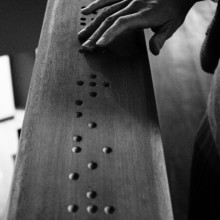In this touchy-feely Question of the Week we find out which bits of the brain interpret text and Braille. Are they the same? Plus, we ask how it is that light bends under gravity, even though it's supposed to be massless!
In this episode

00:00 - How does the brain process Braille?
How does the brain process Braille?
We put this question to Dan Goldreich, associate professor in the Department of Psychology, Neuroscience & Behaviour at McMaster University in Ontario, Canada... Dan: - So, to answer your question, we need to understand how the brain processes both touch and language. With respect to touch, when we move our fingertip over objects such as Braille characters, receptors under the skin produce electrical impulses that race at about 50 meters per second through the nervous system and up towards the brain. This pattern of electrical impulses, a sort of neural Morse code, activates a part of the brain's parietal lobe - roughly halfway between the forehead and the back of the head. This tactile area of the parietal lobe helps to decode the neural impulses, in order to infer the shapes of the objects that touched the skin.
Now, interestingly, in blind people, particularly those blind from birth, touch activates not only this tactile area of the parietal lobe, but also a part of the occipital lobe, in the very back of the head, that is normally reserved for vision. A blind person reading Braille, then, will experience activation of both the tactile area of the brain and the normally visual area of the brain. This unusually extensive brain activation may underlie the heightened sense of touch in blind people. However, in reading Braille, the brain must not only perceive the shapes of the characters, but once it has done so it must understand those shapes as language. This linguistic understanding is probably not occurring in the brain areas I've just mentioned, but rather in the brain's language areas (such as the area of the temporal lobe - above the ear - called Wernicke's area). So a blind person reading Braille is probably using the same language areas of the brain as a sighted person would while reading print, and as you are right now as you understand the words that I'm speaking.
So, "Does the mind process text in a different way when reading Braille?" the answer to the question is both yes and no. Blind people reading Braille do show an unusually extensive pattern of brain activation but, once the brain perceives the tactile shapes, the subsequently activated brain language areas used to understand the Braille words are probably the same as those used to understand printed or spoken words.
*Finger size can also affect tactile acuity: Journal of Neuroscience Dec., 2009: Peters RM, Hackeman E, Goldreich D (2009) Diminutive digits discern delicate details: fingertip size and the sexdifference in tactile spatial acuity. J Neurosci 29: 15756 -15761.










Comments
Add a comment